Menu
Old School
Science Fiction
Today, I want to share with you a list of 10 classic science fiction books that are really important to me and, I think, to the world of literature as well. I chose these books because they each bring something special to the table—not just cool stories or futuristic settings, but real ideas and questions about our world and where we’re headed.
First up, there’s “Frankenstein” by Mary Shelley, which many say is the first real science fiction story ever. It’s about what happens when we try to play God, and it’s still relevant today. Then we’ve got books like “The War of the Worlds” by H.G. Wells, which made everyone think about what would happen if aliens visited us, and “Brave New World” by Aldous Huxley, which shows a future where everyone is supposedly happy, but at a cost.
I’ve also included some books that tackle big brother surveillance and government control, like George Orwell’s “1984” and “Fahrenheit 451” by Ray Bradbury. These books are about more than just the future; they’re about our freedoms and what makes us human.
Later on the list, there’s “Dune” by Frank Herbert, which opened up new worlds and showed us what space empires might look like one day. And I can’t forget “The Left Hand of Darkness” by Ursula K. Le Guin, which challenges how we think about gender and society.
These are the books I picked because they are thought-provoking, imaginative, and challenging reads. They speak to our desires and identities. So let’s get started if you’re ready to discover some of the greatest science fiction has to offer!
Frankenstein, or The Modern Prometheus,

First up, Mary Shelley’s “Frankenstein, or The Modern Prometheus,” isn’t your typical classic book. It’s an innovative work that has had a significant influence on science fiction and literature.
In 1816, when Mary Shelley was eighteen years old, she wrote the first draft of “Frankenstein.” In 1818, the book was first published under a pseudonym.
Many people consider Mary Shelley’s book to be one of the first examples of science fiction. It explored unknown ground when it was published in 1818 by addressing issues such as creation, scientific ambition, and the fallout from unbridled knowledge. It serves as the foundation for all the futuristic and speculative stories we enjoy today, almost like a blueprint for the entire science fiction genre.
However, “Frankenstein” explores deeper themes than only futuristic technology. philosophical and ethical questions that are still relevant today. It forces readers to ponder the essence of humanity, the responsibilities that come with creation, and the dangerous pursuit of knowledge without ethical considerations. Shelley’s storytelling invites us to empathize with both Dr. Frankenstein and his monstrous creation, prompting us to reflect on the moral dimensions of scientific discovery and personal ambition.
While it’s a cornerstone of science fiction, “Frankenstein” also has strong ties to the Gothic and Romantic literary traditions. Its themes of nature’s beauty, emotional intensity, and individualism align it with the Romantic movement, while its eerie settings and exploration of horror and psychological depth embrace the Gothic elements. This blend of genres adds layers to the story and contributes to its lasting appeal.
The cultural impact of “Frankenstein” is colossal. The image of Frankenstein’s creature has become iconic, symbolizing the perils of unchecked ambition and societal rejection of the different. The story has been adapted into countless films, plays, TV shows, and other media, each interpreting its themes in unique ways. The term “Frankenstein” has become synonymous with any creation that spirals out of control, a testament to the enduring relevance of Shelley’s cautionary tale.
Mary Shelley’s brilliance shines through not only in her storytelling but also in her innovative approach to narrative structure. She penned “Frankenstein” at the tender age of 18, yet her use of nested narratives and epistolary elements was remarkably advanced for her time. Her vivid descriptive language, exploration of the human psyche, and rich literary depth have secured “Frankenstein” a place as a masterpiece of English literature.
In conclusion, “Frankenstein” is a literary and scientific marvel. It birthed the science fiction genre, wrestled with profound questions, melded Gothic and Romantic elements, left an indelible mark on pop culture, and showcased the genius of Mary Shelley. It’s a timeless tale that continues to spark conversations and ignite creativity, appealing to both literature lovers and science fiction enthusiasts alike. If you haven’t delved into its pages yet, it’s high time you did.
The War of the Worlds
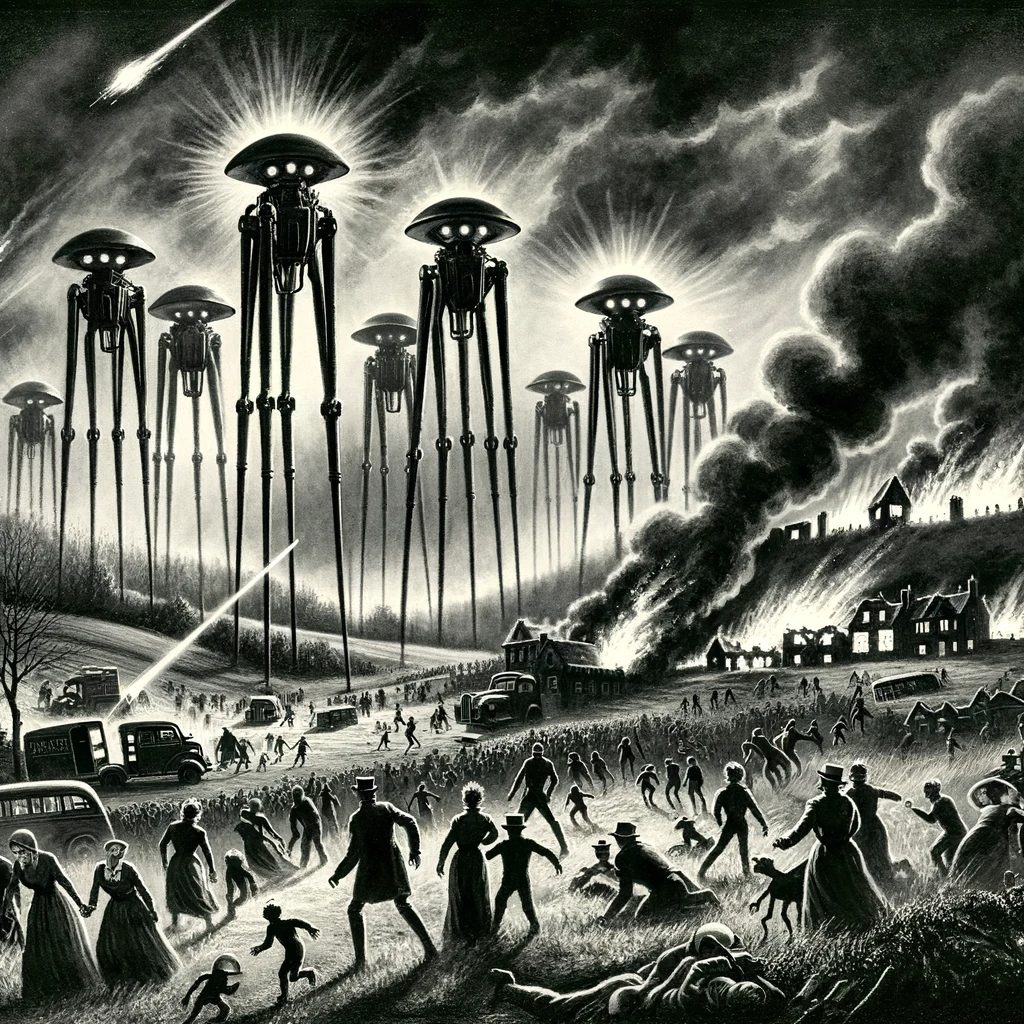
H.G. Wells’ 1898 novel “The War of the Worlds” is one of the first tales to describe a battle between humans and aliens. This groundbreaking science fiction classic has spawned a plethora of sequels and ripoffs. The narrative, which takes place in late 19th-century England, describes the terrible Martian invasion of Earth as well as the widespread fear and destruction that followed. Wells tells a terrifying story of the devastation and human powerlessness caused by the sophisticated Martians destroying the cities and countryside with their tall tripods loaded with heat-rays and toxic black smoke.
An anonymous everyman who serves as the protagonist describes his adventures and interactions while he tries to fend off the invaders, who seem to be unstoppable. The Martians represent the fear of the unknown and the possible disastrous effects of coming into contact with more developed civilizations because of their superior technology and disdain for human life. In addition, “The War of the Worlds” is a critique of British imperialism and the human propensity for complacency in the face of possible dangers.
Wells’ indictment of the colonial attitudes of the period and the frailty of human authority is reflected in the novel’s portrayal of England, the superpower of the day, being easily conquered by Martians. The final loss of the Martians to bacteria, the smallest living thing on Earth, highlights the interconnectedness of all life and the unexpected fragility of even the strongest creatures. Beyond its gripping story, the book is renowned for its creative portrayal of alien technology and colorful imagery, both of which have had a significant impact on the science fiction subgenre. The quintessential sign of alien menace is the picture of the Martian tripods marching across the English countryside. Wells gives the narrative a feeling of reality that heightens the sensation of horror by using a scientific foundation and paying close attention to detail while explaining the technology of the Martians and how humans react to their invasion. “The War of the Worlds” is still regarded as a seminal book that inspires contemplation on issues like the moral ramifications of imperialism, the repercussions of unchecked technological growth, and humanity’s role in the cosmos. Its influence can still be found in the enormous corpus of writing and visual arts that tackle the subject of extraterrestrial invasion and how humanity reacts to such grave dangers.
The Time Machine
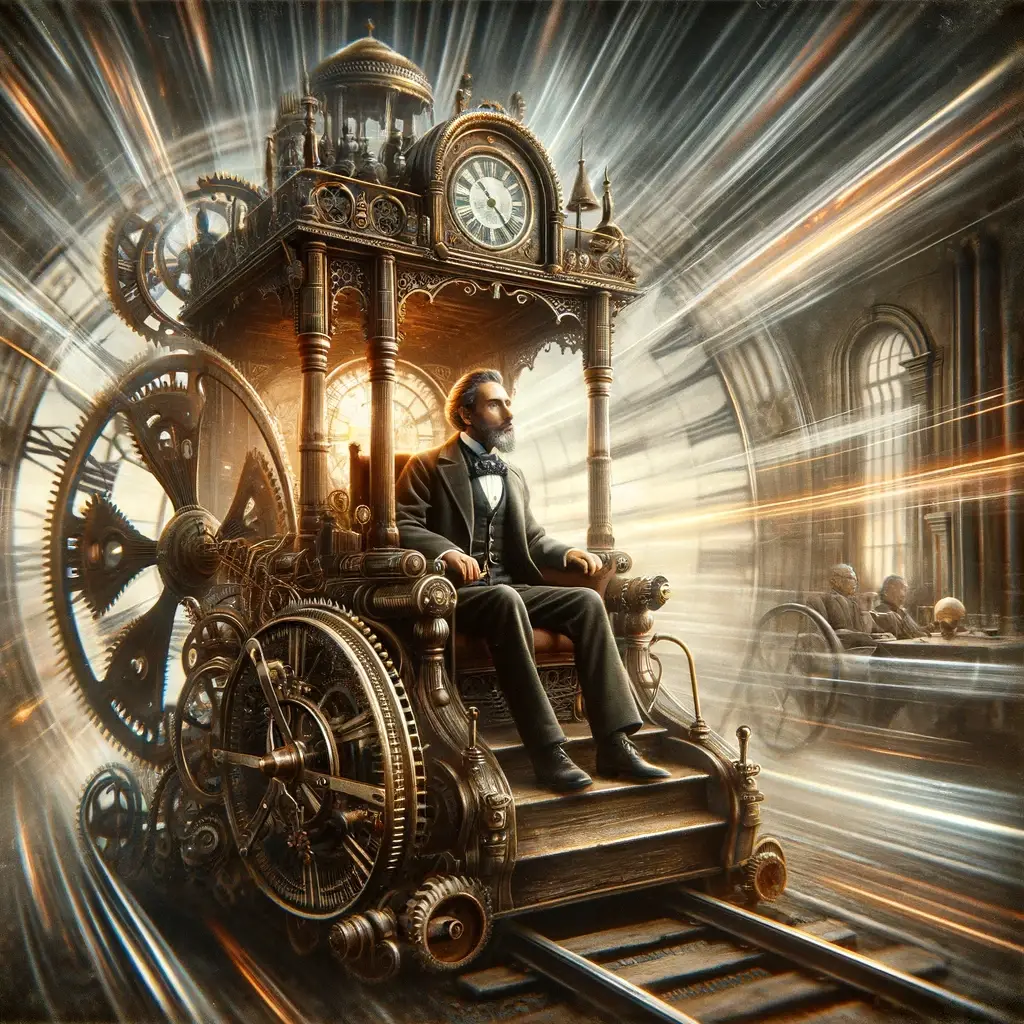
The science fiction classic “The Time Machine” by H.G. Wells, which debuted in 1895, is credited with popularizing the idea of time travel using a mechanical apparatus. The protagonist of the book, who goes by the moniker “the Time Traveler,” creates a device that lets him travel across time. Through the prism of futurism, the story explores topics of development, society, and the human condition in a way that combines adventure and philosophical investigation.
The Time Traveler travels to a far-off future Earth, where he meets two different human-derived species: the Eloi, a kind and innocent people living a seemingly perfect life on the surface, and the Morlocks, ominous creatures that live underground and hunt the Eloi. The protagonist muses on the sociological and evolutionary processes that may have formed such a split society as he investigates this odd new planet. Extrapolated into a harsh picture of the future, the day traveler’s views and experiences comment on the social Darwinism and class differences of Wells’ own day.
Fundamentally, “The Time Machine” is a warning against complacency and the unintended effects of societal and technical advancement. Using the Time Traveler’s voyage, Wells challenges the idealistic visions of utopia that were popular in the 19th century by arguing that the future may not be perfect if human nature and social structures are not carefully taken into account. The novella also explores the existential ramifications of time travel, reflecting on the meaninglessness of human accomplishments and lifespans in the grand scheme of cosmic time.
“The Time Machine” stands out for its groundbreaking contribution to science fiction literature, in addition to its rich narrative and thematic depth. It added to the genre’s ongoing preoccupation with temporal adventures by inspiring a generation of authors and artists to investigate the potential and contradictions of time travel. The novella captivates readers with its combination of speculative science and profound investigation into the human soul, earning it a position as a classic of literature thanks to its vivid imagery, inventive world-building, and meditative tone.
“The Time Machine” is still praised for its avant-garde style and capacity to elicit discussion on the course of human development, the makeup of society, and our perception of time. This exciting story and work of speculative philosophy continue to be important topics of conversation on the promise and danger of our scientific and cultural paths.
Brave New World
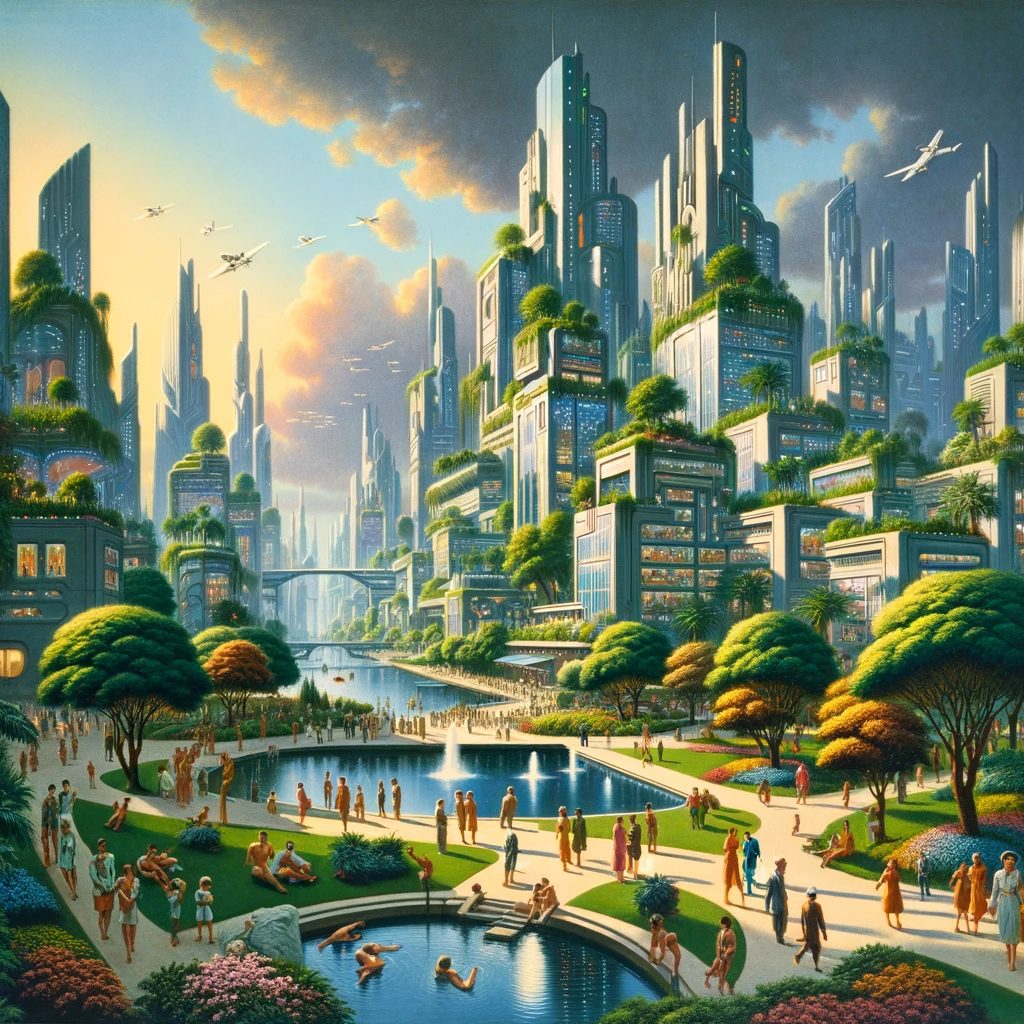
Aldous Huxley’s groundbreaking novel “Brave New World,” which was released in 1932, depicts a terrifying dystopia that passes for a paradise. The novel, which is set in the year 2540 (or 632 A.F. in the book, which means “After Ford”), foresees a variety of scientific advancements in the areas of sleep training, reproductive technology, psychological manipulation, and classical conditioning that would together drastically alter society.
“Brave New World” presents a world where social stratification is severe, forced happiness is the norm, and individuality is completely destroyed. Instead of being born, people are now made in hatcheries and trained to fit into one of five castes: Epsilon, Beta, Gamma, Delta, or Alpha, each of which is assigned a specific duty in society. “Community, Identity, Stability,” the slogan of the World State, indicates its emphasis on suppressing individuality and promoting group uniformity. The general public uses the hallucinogenic drug Soma to avoid suffering and preserve a flimsy sense of enjoyment.
In contrast to many dystopian stories that depict a dictator in charge or an oppressive government, “Brave New World” shows a civilization that appears to have accepted its limitations. What makes the dystopian scenario even more unsettling is that the people living in the scenario state are not subjugated by force but rather by their own conditioned ignorance. The book explores the price of continuous happiness and what aspects of humanity—like family, art, and religion—might be lost in the hunt for it.
Bernard Marx, the main character, and his companion John, also referred to as the “Savage,” who was not born into the society of the World State, provide opposing viewpoints on the society they live in. Huxley examines issues of technological development, personal autonomy against governmental regulation, and the search for purpose and connection in human existence through their eyes.
The issue in “Brave New World” on the ethical implications of modifying human genetics and psychology, as well as the effects of technology development on humanity, is still incredibly pertinent today. It makes one reflect on the ideals of contemporary society, the significance of human misery, and the cost of maintaining a clean, well-organized society. The language and concepts of the novel have permeated popular culture and continue to spark discussion on the future course of human communities, demonstrating the work’s lasting effect.
1984

George Orwell’s iconic work of 20th-century literature, “1984”, paints a dismal picture of a society run by dictatorship. First published in 1949, the novel imagines a dystopian future when warfare, continual government surveillance, and public manipulation are the norm. The plot takes place on Airstrip One (formerly Great Britain), a province of the superstate Oceania, in a cosmos consisting of three warring states.
The protagonist, Winston Smith, works for the Ministry of Truth and belongs to the outside party. There, it is his job to alter records of the past to make the party’s account of events the only one that remains. Winston is more irritated with the Party’s repressive control over history, language, and ideas, among other aspects of life. To maintain control over its citizens, the Party, led by the enigmatic figure of Big Brother, employs both physical and psychological intimidation.
One of the novel’s most important aspects is the language of Newspeak, which is designed to limit freedom of thought—personal identity, self-expression, and alternative ideas are all but impossible under its tight constraints. A few phrases and concepts from the book that have persisted in popular culture are Big Brother, thoughtcrime, doublethink, and Room 101, illustrating its continuing influence on language and concepts.
George Orwell’s short fiction “1984” is a sobering warning against the abuses of authoritarian power as well as a cautionary tale about what happens when a society sacrifices freedom for security. Its importance only appears to increase over time as it takes into account concerns about censorship, tracking, and the invasive role that technology plays in our lives. It’s still a powerful conversation starter on liberty, truth, and the need to be on guard against the spread of authoritarian ideologies.
“1984”, despite its publication over seven decades ago, is a critical mirror reflecting contemporary political and social issues and encouraging readers to fight for a future where truth and freedom are valued and to be wary of those in positions of control. It is a famous piece of literature that never fails to horrify, fascinate, and ignite conversations about society’s fate because of its literary expertise in blending political and psychological tales.
Foundation
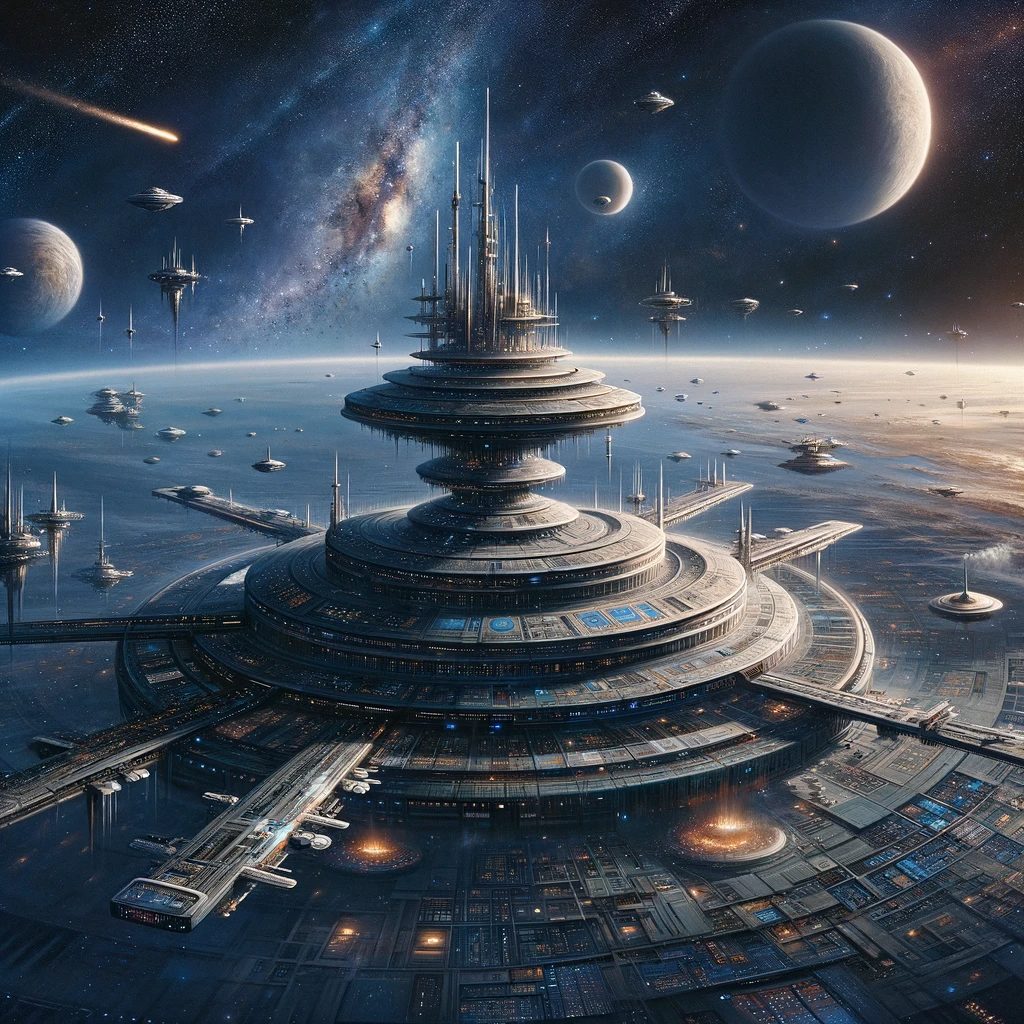
Isaac Asimov’s “Foundation,” one of the most well-known works of science fiction literature, made its debut in 1951 and launched the Foundation series. Essentially, the book is an anthology of short stories that Asimov gathered and reissued from 1942 to 1950 in order to tell a coherent narrative. “Foundation” is set in a far-off future where the focus is on the fall of the Galactic Empire and the scientific endeavor led by psychohistorian Hari Seldon to decrease the duration of the next dark age.
“Foundation” is based mostly on psychohistory, an invented mathematical sociology that combines sociology, statistics, and history to predict the future of large populations. Seldon uses psychohistory to forecast the collapse of the Galactic Empire, which has ruled over peace and prosperity for endless years. He then comes up with a plan to reduce the duration of the next 30,000-year period of turbulence to only 1,000 years. This plan called for the most intelligent and gifted individuals to create two foundations at opposite ends of the galaxy in order to preserve and expand human knowledge, which would eventually act as the new empire’s cornerstone.
The “Foundation” narrative spans many centuries, following the organization’s growth from a small, helpless outpost to a powerful political and technological powerhouse. Through the challenges the Foundation encounters, Asimov explores a range of social, political, and moral dilemmas. The people of the Foundation navigate treachery, conflict, and economic manipulation under the guidance of Seldon’s psychohistorical plan—a subtle but forceful force that permeates the whole plot—as each story arc tackles a different issue.
We applaud “Foundation” for its creativity, especially the concept of psychohistory, which offers a unique viewpoint on the rise and fall of civilizations. Not only does Asimov’s futuristic vision span the cosmos, but it also offers a comprehensive understanding of human nature and social dynamics. The book raises important questions about determinism, free will, and people’s role in the greater scheme of things.
A mainstay of the science fiction genre, “Foundation” has had a profound impact on subsequent literature and culture. Its influence extends beyond the pages of the book; both readers and artists are inspired by its bold narrative and compelling depiction of humanity’s place in the cosmos. When people discuss the future, our common destiny, and how resourceful individuals can be when presented with new problems, the show is still a hot topic.
Fahrenheit 451
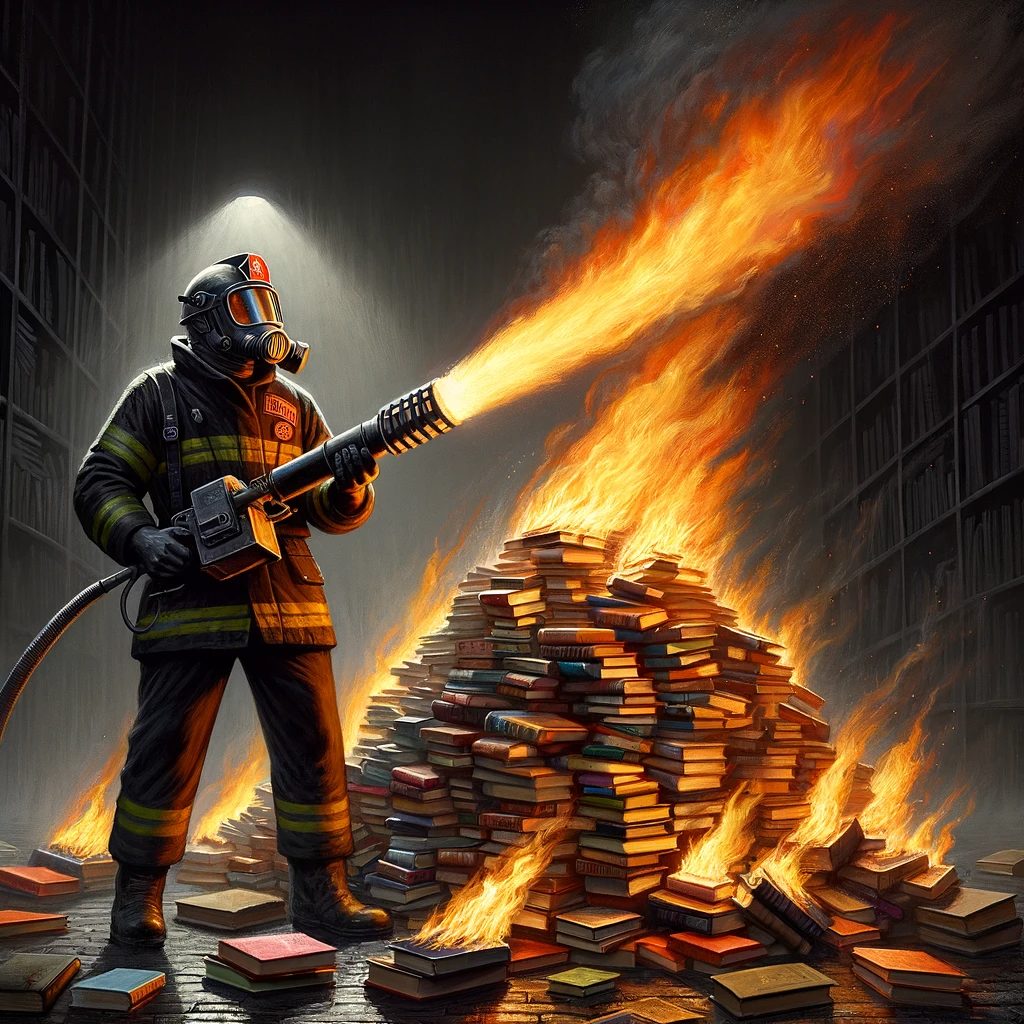
Ray Bradbury’s science fiction novel “Fahrenheit 451,” published in 1953, examines censorship, the place of knowledge in society, and the results of purposeful ignorance. It’s a well-known and captivating piece of writing. The title alludes to the work’s main problem, which is the use of book burning as a tool of oppression, by mentioning the temperature at which book paper burns and ignites. Guy Montag, a firefighter who becomes fed up with his society’s anti-intellectualism and conformity, is at the center of this dystopian future novel, in which books are outlawed and “firemen” burn any that are discovered.
Montag is living in a society that values entertainment, instant gratification, and flimsy art over independence and critical thought when he first embarks on his journey. After meeting the outgoing, outdoorsy, and curious young woman, Clarisse, he undergoes a transformation. Realizing that his life is pointless and that opposing views are suppressed, Montag begins to question the ethics and motivations underlying his work as a fireman. Driven by his unquenchable curiosity, he sets off on a treacherous journey of intellectual exploration and rebellion to read the books he is supposed to burn in secret.
“Fahrenheit 451” criticizes willful ignorance and thought suppression. Bradbury’s illustrations depict a society where people are rendered unconscious by mindless entertainment and isolated from more introspective and emotional pursuits, the natural world, history, and culture. Asserting that losing the ability to think critically and introspectively may lead to the loss of one’s independence and the essence of what it is to be human, the book warns against letting fear and haste dictate one’s thoughts and words.
The narrative delivers lessons on the importance of free thought and the transformative power of literature, in addition to acting as a cautionary tale about governmental control and censorship. The novel’s themes of the value of education, relating to others via similar experiences and viewpoints, and questioning authority figures are all highlighted by Montag’s transformation from an obedient subject of tyranny to a person willing to give up all for the preservation of knowledge.
“Fahrenheit 451” remains a powerful and pertinent book despite the ongoing discussions about free speech, the effects of technology on society, and the need to preserve a range of voices and viewpoints. Discussions regarding the importance of valuing, defending, and engaging in the cultural and intellectual facets of human existence are sparked by its striking depiction of a society in which literature and critical thought are ignored in the future.
Bradbury’s masterful storytelling makes “Fahrenheit 451” a potent cautionary tale about the dangers of information repression and the persecution of dissident voices. The McCarthy era in American history, when people suffered unjust persecution and limitations due to their connections and ideas, is strikingly similar to this period.
Because it highlights how important it is to defend people’s freedom of expression and ideas in any society, this comparison is incredibly pertinent. Stories like “Fahrenheit 451” and McCarthyism serve as cautionary tales, pleading with us to protect against totalitarian ideologies and preserve the invaluable library of ideas contained in books. They act as a warning that concealing information eventually impedes progress and weakens our fundamental freedoms.
Childhood's End
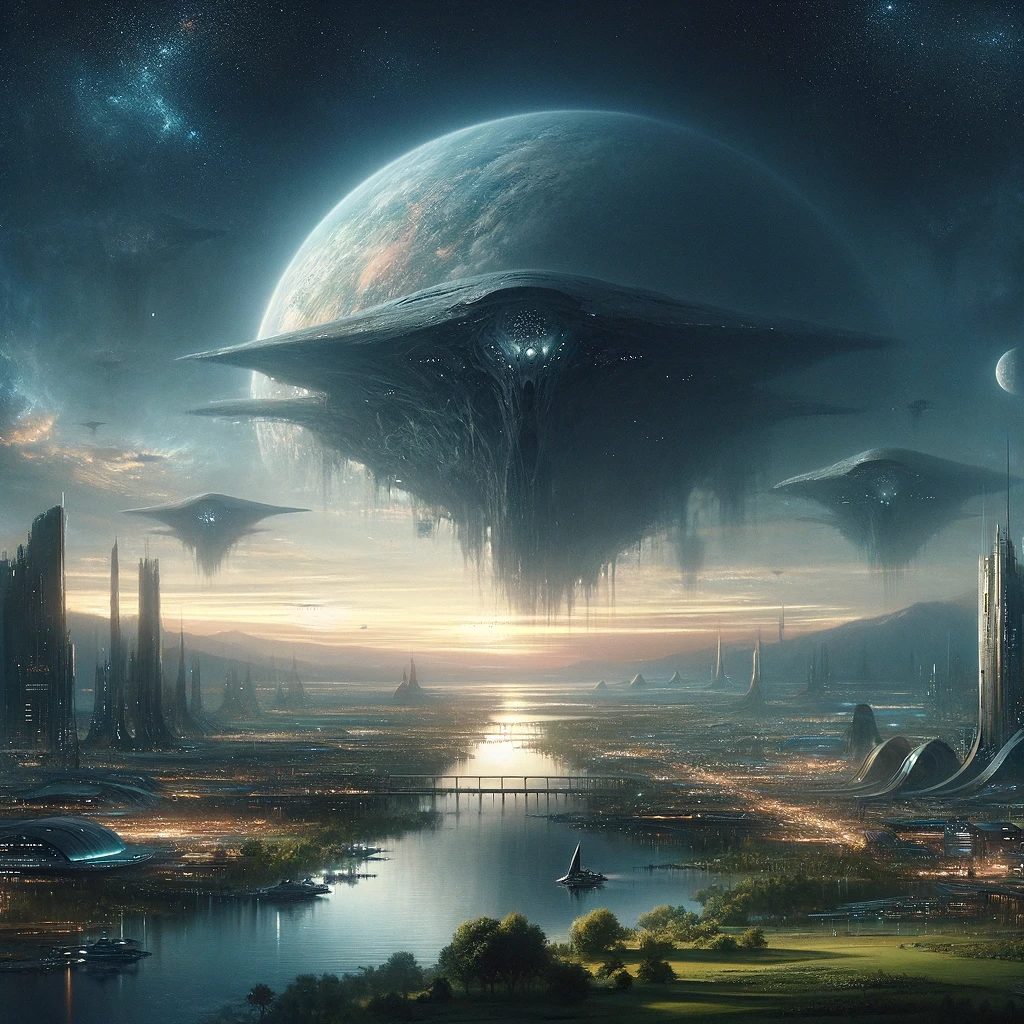
Arthur C. Clarke’s original 1953 science fiction novel “Childhood’s End” is regarded as a classic in the field for its expansive imagination and profound philosophical analysis. The beginning of the book sees the peaceful takeover of Earth by enigmatic extraterrestrial overlords who eradicate suffering, conflict, and poverty. At the expense of cultural and personal identity, this golden age brings in a new period of wealth and an idealized world. Questions about freedom, innovation, and the destiny of mankind start to surface as people live an apparently ideal existence under the benevolent government of the Overlords.
The Overlords are mysterious; they only engage with humanity through one specific liaison and conceal their appearance and intentions. After several decades, it becomes clear that the Overlords’ goal is closely related to the development of human progeny and the enigmatic cosmic destiny of humanity. The book progressively exposes the metamorphosis that mankind experiences, culminating in a startling and moving denouement on the transcendence of the human race.
The epic narrative arc of “Childhood’s End” is praised for encompassing the existential journey of the human race as a whole. In addition to exploring the philosophical aspects of human life, Clarke’s visionary fiction also addresses the social ramifications of a utopian global order. The story suggests that every golden era may have unintended effects as it examines the boundaries of human understanding and the bittersweet nature of development.
Themes from “Childhood’s End” illustrate Clarke’s ongoing concern about the dual nature of technology and society’s progress. Not only does the book provide an amazing look into the future, but it also addresses significant ethical and philosophical questions, such as what it means to be human. What fate awaits our species in the end? Do the ends signify a new beginning? “Childhood’s End” has persisted as a genre classic in part because of Clarke’s ability to blend deep philosophical investigation with hard science fiction.
A classic of science fiction literature, “Childhood’s End” delves deeply into the question of humanity’s role in the cosmos. The innumerable science fiction novels that have come after it, as well as the continuous debates over humanity’s place in an ever-more intricate and linked universe, bear witness to its influence. Readers are still enthralled by Arthur C. Clarke’s masterwork because of its surreal story about the end of one era and the enigmatic beginning of another.
Dune

First published in 1965, Frank Herbert’s “Dune” is a seminal work of science fiction. Taking place in a feudal interplanetary civilization in the far future, the book delves into intricate subjects of politics, religion, environment, technology, and human emotions. The desert planet Arrakis, often called Dune, is the focal point of the tale since it is the only place to get Melange, the spice that increases mental capacity and prolongs life, the most precious commodity in the cosmos. Thus, commanding Arrakis is a highly desired and perilous role.
The youthful Paul Atreides, whose aristocratic family takes over Arrakis, is the book’s main character. Paul’s story traces his development from a young heir forced from his family by political betrayal to the messianic leader of the Fremen, the planet’s indigenous population. Throughout Paul’s journey, Herbert looks at questions of prophecy, authority, and Paul’s transformation into Muad’Dib. The intricate social, ecological, and economic systems of Arrakis are brilliantly brought to life with its massive sandworms and spice manufacturing, echoing Herbert’s observations of contemporary issues like resource exploitation and the complexity of heroism.
“Dune” is lauded not only for its grand narrative but also for its deep philosophical underpinnings. It investigates the essence of human desires for power and the inevitable consequences of such aspirations. Herbert skillfully weaves a story that raises ethical questions about messianic zeal and leadership while pressing readers to consider the implications of ecological and cultural interaction. The religious and spiritual aspects of the book draw from a variety of sources, adding further depth to the surroundings and the people.
“Dune” has had a significant impact on the science fiction genre. Rich world-building, nuanced character development, and careful subject study have all served as inspiration for a wide range of other works. The novel was ahead of its time in emphasizing ecology, especially the delicate balance of life in Arrakis’s desert environment. It anticipated contemporary worries about environmental sustainability and the effects of depleting natural resources.
“Dune” is recognized as a classic science fiction book because it offers a thorough analysis of human nature and societal dynamics. Both the mental and exterior landscapes of the characters are equally important to the plot. The pinnacle of science fiction, “Dune” captivates readers of all ages with its daring breadth and everlasting relevance.
The Left Hand of Darkness
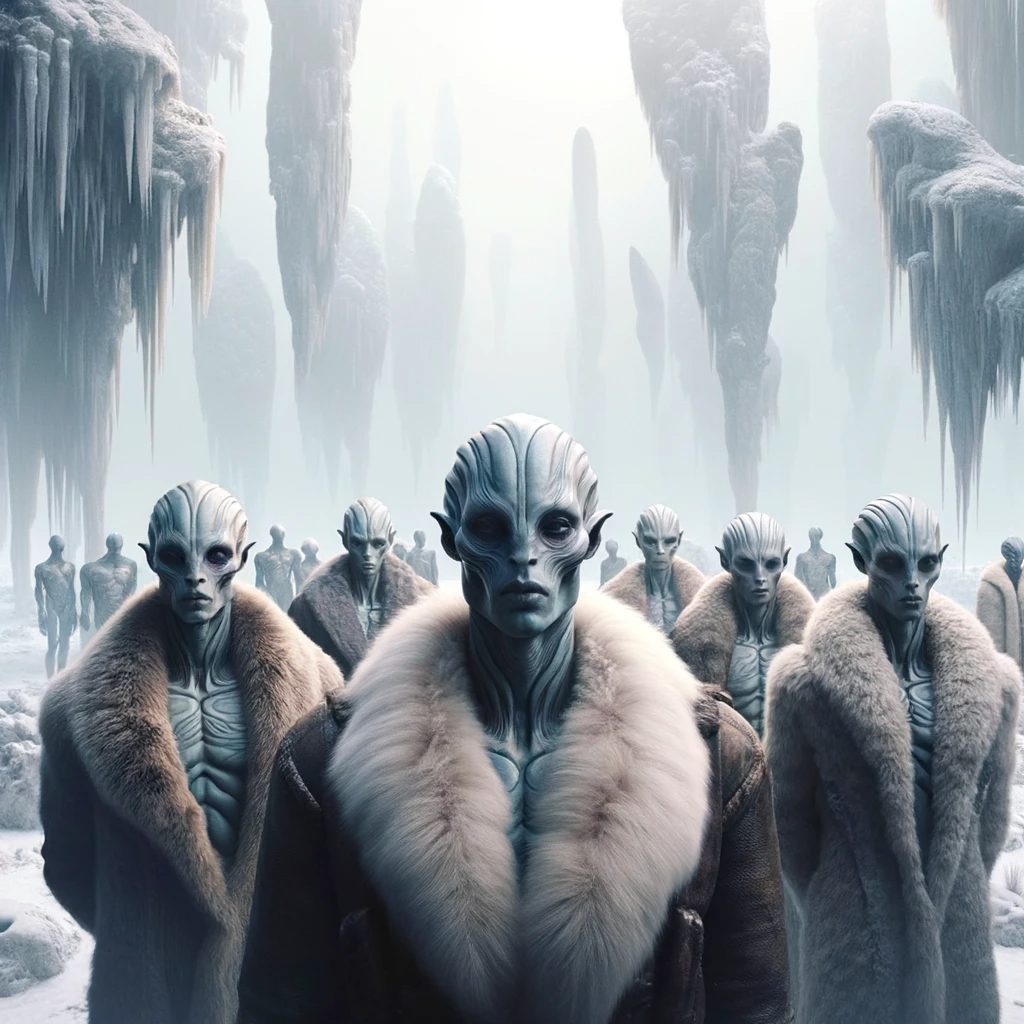
Published in 1969, Ursula K. Le Guin’s “The Left Hand of Darkness” is a landmark science fiction book that is renowned for its groundbreaking examination of gender and its subversion of conventional ideas around sexuality and society. Part of Le Guin’s Hainish Cycle, a loosely connected series of books that examine distinct human civilizations on different planets, the novel is set on the planet Gethen, sometimes known as Winter. A human ambassador named Genly Ai is dispatched to Gethen in “The Left Hand of Darkness” with the intention of convincing its leaders to become members of the Ekumen, a collection of planets.
Gethen, a planet with bitterly cold temperatures, is the home of Gethenians, ambisexual people. They go through a brief, fertile period called kemmer, when they become male or female for the majority of their monthly cycle, transforming from being sexually dormant. This aspect of Gethenian biology, which eliminates the traditional gender roles found in human society, makes Gethenian culture and civilization very distinct from those of other worlds, including Earth. Through the eyes of AI, Le Guin explores the ways in which this sexual orientation impacts politics, society, and interpersonal relationships.
The story takes the reader on an exciting adventure as well as a contemplative and intellectual one. The work explores themes of treachery, loyalty, and the existential loneliness of being an outsider in a foreign place as Ai makes her way through Gethen’s complicated political terrain and develops a close relationship with Estraven, a native Gethennian. The narrative offers an insightful reflection on the partitions we build with our ideas of gender, nationality, and loyalty—and how such partitions may dissolve in other situations.
Le Guin, who is well-known for her exquisite storytelling and deep knowledge of anthropology, conveys a tale that is both personal and universal. “The Left Hand of Darkness” has received recognition for its bold examination of gender and sexuality norms as well as its inventive world-building. It presents an image of a society in which these categories are vastly unlike our own, challenging the reader’s belief that identity-determining categories are malleable and culturally constructed.
A classic piece of speculative fiction, “The Left Hand of Darkness” is lauded for progressing discussions about women and society, as well as for its literary skill and intellectual bravery. Discussions on inclusivity, diversity, and the many variations in human identity still frequently touch on this subject. Because of Le Guin’s outstanding storytelling and perceptive reflections on human nature, this book is a classic that is still relevant today.